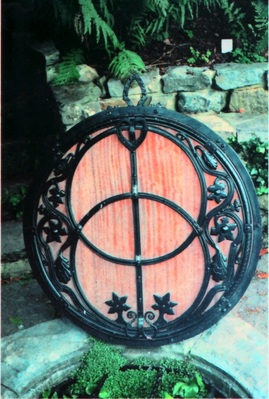Chalice Well, Glastonbury, Somerset
By zteve t evans
Chalice Well is a natural spring surrounded by gardens situated at the foot of Glastonbury Tor near the town of Glastonbury in the English county of Somerset. Today it is managed by the Chalice Well Trust which was founded in 1959 by Wellesley Tudor Pole and is a grade 1 listed building. In 2009, the the Exeter University School conducted research which revealed the well was fed by an aquifer.
 Cover of the Chalice Well - Author: Theangryblackwoman
Cover of the Chalice Well - Author: Theangryblackwoman
The waters of the well
The well is sometimes called the Red, or Blood Spring as the water is coloured a reddish hue by the presence of ferrous oxide hat becomes oxidized at the surface. The well gives forth 25,000 gallons of water a day and is said to have never failed even during periods of severe drought. The waters are warm and said to possess healing attributes. The reddish colouring is said to represent the nails the Cross that Jesus died on rusting.
The waters of the well are warmer than the surface ground temperature and nearby vegetation benefits from this flowering when it is too cold for flora further away to.
History
Flints and shards of pottery have been discovered from the Paleolithic and Mesolithic age and a shard of pottery found dates from the Iron Age. Shards of pottery have also been found dating from Roman and Medieval times. Archaeologists think the site has been in human use for at least 2,000 years.
The White Spring
A short way to the east another natural spring bubbles out of the ground known as the White Spring. Its waters are colourless and originate from a shallower aquifer. A waterworks building was constructed over it but now serves as a place of worship, though opening times are irregular.
Joseph of Arimathea
According to legend when Joseph of Arimathea came to England He brought along with him the cup Christ used at the Last Supper to serve his followers wine. Immediately after Joseph had hidden the chalice the waters of the spring were sad to have turned red. The Holy Chalice became associated and eventually interchangeable with the Holy Grail which originated in Arthurian legends.
The Chalice Gardens
A number events are held in the gardens of Chalice Well each year. The summer and winter solstices are celebrated annually along with World Peace Day, Michaelmas and Samhain also known as Halloween. The Chalice Gardens are open most days of the year and there is a reasonable charge.
© 18/01/2015 zteve t evans
The well is sometimes called the Red, or Blood Spring as the water is coloured a reddish hue by the presence of ferrous oxide hat becomes oxidized at the surface. The well gives forth 25,000 gallons of water a day and is said to have never failed even during periods of severe drought. The waters are warm and said to possess healing attributes. The reddish colouring is said to represent the nails the Cross that Jesus died on rusting.
The waters of the well are warmer than the surface ground temperature and nearby vegetation benefits from this flowering when it is too cold for flora further away to.
History
Flints and shards of pottery have been discovered from the Paleolithic and Mesolithic age and a shard of pottery found dates from the Iron Age. Shards of pottery have also been found dating from Roman and Medieval times. Archaeologists think the site has been in human use for at least 2,000 years.
The White Spring
A short way to the east another natural spring bubbles out of the ground known as the White Spring. Its waters are colourless and originate from a shallower aquifer. A waterworks building was constructed over it but now serves as a place of worship, though opening times are irregular.
Joseph of Arimathea
According to legend when Joseph of Arimathea came to England He brought along with him the cup Christ used at the Last Supper to serve his followers wine. Immediately after Joseph had hidden the chalice the waters of the spring were sad to have turned red. The Holy Chalice became associated and eventually interchangeable with the Holy Grail which originated in Arthurian legends.
The Chalice Gardens
A number events are held in the gardens of Chalice Well each year. The summer and winter solstices are celebrated annually along with World Peace Day, Michaelmas and Samhain also known as Halloween. The Chalice Gardens are open most days of the year and there is a reasonable charge.
© 18/01/2015 zteve t evans
References and Attributions
Copyright January 18th, 2015 zteve t evans
Copyright January 18th, 2015 zteve t evans
- Chalice Well Cover - CC BY 2.5 - Theangryblackwoman at en.wikipedia
- Chalice Well Trust Gardens - A Living Sanctuary .
- Chalice Well - Wikipedia, the free encyclopedia
- Holy Grail - Wikipedia, the free encyclopedia
